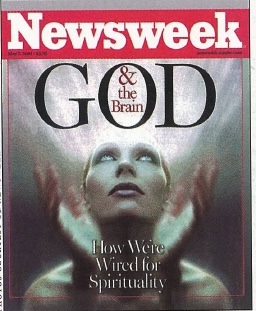God made Newsweek but yoga’s on Time. In a departure from politics as usual, both magazines Time and Newsweek recently ran ten-page cover stories just two weeks apart centering on growing scientific interest and insights into the ancient, Eastern, mystical practices of yoga and meditation. Although a Hindu or Buddhist might find that both articles lack spiritual depth, the very mention of any subject centering on yoga and meditation in such media is significant, especially when the appreciation and approval of the scientific community is present. Such articles honor the long-term, tireless and persistent efforts of sincere Hindu and Buddhist monks, sadhus and swamis who for more than 100 years have patiently and incrementally channeled the ancient Eastern mystical teachings to the West. Although their job is not done, it is certainly in process.
Newsweek reported on an innovative brain-imaging machine called SPECT (single photon emission computed tomography) that records brain activity (or its lack) during meditation and prayer. Time discussed new test results showing encouraging health and medical benefits derived from meditation and yoga. Prompted in part by yoga’s low-tech, low-cost solutions to certain medical problems, science and medicine are tentatively venturing beyond their traditional boundaries. The University of Pennsylvania even opened a new department, neurotheology, to encompass the ground-breaking work of their SPECT machine.
“In the new field of neurotheology,” poses Newsweek’s Sharon Begley, “scientists seek the biological basis of spirituality. Is God all in our heads?” You won’t find here the Hindu concepts that God is the essence of all form, including the brain, or that the soul has a body. Instead, the article is agnostic in approach, uncertain about the existence of God. Is God simply the product of an “electrical storm in the temporal lobes” of the brain, she asks, or does He actually exist, only to be perceived differently by each of us through the filter of our individual brains. This decidedly nonmystical approach is, ironically, any good skeptic’s first step toward mysticism.
Neurotheology began 19 years ago with an unbidden mystical experience of Dr. James Austin. For Austin, a neurologist, this other-worldly event was not “proof of God” but rather “proof of the existence of the brain.” The experience, which made him feel that “the sense of I, me and mine had disappeared, and time was not present,” inspired him to research the phenomenon and finally write in 1998, the 844-page Zen and the Brain, published by none other than the prestigious MIT Press. Inspired by Austin and others like him, many scientists are now feeling the mysterious pull of neurotheology.
One, Dr. Andrew Newberg at Pennsylvania, hooked Tibetan Buddhist monks and Franciscan nuns to his SPECT machine. Each subject settled into a comfortable meditation chamber, suitably outfitted to his or her liking. As his focus penetrated to its maximum depth, he tugged on a piece of twine connected to SPECT’s operator in the next room, who quickly injected a radioactive tracer into an IV line that ran into the subject’s left arm. A few moments later a SPECT image tracked the tracer in the blood flow of the brain, indicating neuronal activity. The resulting pictures clearly showed that certain portions of the brain previously active became quiet, while other areas that were quiet now became active. From this it was determined which sectors of the brain were stimulated or pacified during different meditative practices [see diagram], including religious thought, spiritual devotion, focused concentration and a sense of “cosmic unity.” To date, this has been science’s best “snapshot” of mystic experience and has provided enough factual evidence to support enthusiastic future research.
Begley also shares an assortment of inspired dream and vision testimonials from a variety of people, which supplement the laboratory work. Tibetan Buddhist monks, Franciscan nuns, college professors, neurologists, authors and philosophers from different cultures and countries around the globe all give similar descriptions of their experiences. This similarity is difficult to dismiss.
In conclusion, Begley laments, “For all the tentative successes that scientists are scoring in their search for the biological basis of religious, spiritual and mystical experience, one mystery will surely lie forever beyond their grasp…. They will never resolve the greatest question of all namely, whether our brain wiring creates God, or whether God created our brain wiring. Which you believe is, in the end, a matter of faith.”
Time’s article, on the other hand, didn’t ponder such profundities of belief. Richard Corliss’ cover story is a well-informed article on yoga. Although the word yoga spent years in the dictionary, it did not find Time in such a major way until the prestigious journal turned the ripe old age of 78 this last March.
Corliss provides an upbeat and unsatirical analysis of a subject often ridiculed and misunderstood. He accomplishes this with thorough research, good writing, the personal testimony of yoga practitioners and most importantly compelling test results from medical studies showing the positive effects of yoga on health. His article showcases informative and aesthetic photographs of hatha yoga postures superbly performed. It offers a well-researched and illustrated presentation of the mystical and scientific effects of yoga on the body and the chakras, or force centers, within the body certainly a first for any US mainstream secular publication. It explains and illustrates the famous hatha yoga sequence: the twelve-step “Sun Salutation.” To emphasize the growing US popularity of yoga, the article provides a virtual who’s-who register of America’s most influential yoga buffs, such as talk show host Oprah Winfrey and health champion Jane Fonda. Croliss traces the history of yoga in America through a
It’s about TIME: Time’s first-ever yoga feature says fifteen-million Americans practice the ancient art, with media stars like model Christy Turlington leading the way. Another first, the Eastern chakra system is illustrated and explained in connection with the scientific effects of yoga on the body.
